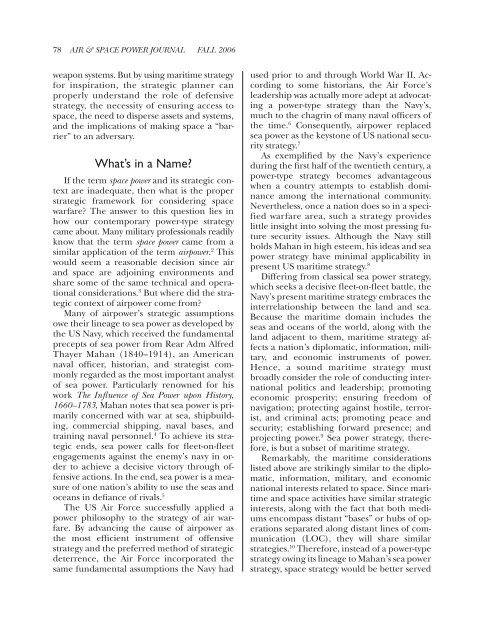Fall 2006 - Air & Space Power Chronicle - Air Force Link
Fall 2006 - Air & Space Power Chronicle - Air Force Link
Fall 2006 - Air & Space Power Chronicle - Air Force Link
Create successful ePaper yourself
Turn your PDF publications into a flip-book with our unique Google optimized e-Paper software.
78 AIR & SPACE POWER JOURNAL FALL <strong>2006</strong>weapon systems. But by using maritime strategyfor inspiration, the strategic planner canproperly understand the role of defensivestrategy, the necessity of ensuring access tospace, the need to disperse assets and systems,and the implications of making space a “barrier”to an adversary.What’s in a Name?If the term space power and its strategic contextare inadequate, then what is the properstrategic framework for considering spacewarfare? The answer to this question lies inhow our contemporary power-type strategycame about. Many military professionals readilyknow that the term space power came from asimilar application of the term airpower. 2 Thiswould seem a reasonable decision since airand space are adjoining environments andshare some of the same technical and operationalconsiderations. 3 But where did the strategiccontext of airpower come from?Many of airpower’s strategic assumptionsowe their lineage to sea power as developed bythe US Navy, which received the fundamentalprecepts of sea power from Rear Adm AlfredThayer Mahan (1840–1914), an Americannaval officer, historian, and strategist commonlyregarded as the most important analystof sea power. Particularly renowned for hiswork The Influence of Sea <strong>Power</strong> upon History,1660–1783, Mahan notes that sea power is primarilyconcerned with war at sea, shipbuilding,commercial shipping, naval bases, andtraining naval personnel. 4 To achieve its strategicends, sea power calls for fleet-on-fleetengagements against the enemy’s navy in orderto achieve a decisive victory through offensiveactions. In the end, sea power is a measureof one nation’s ability to use the seas andoceans in defiance of rivals. 5The US <strong>Air</strong> <strong>Force</strong> successfully applied apower philosophy to the strategy of air warfare.By advancing the cause of airpower asthe most efficient instrument of offensivestrategy and the preferred method of strategicdeterrence, the <strong>Air</strong> <strong>Force</strong> incorporated thesame fundamental assumptions the Navy hadused prior to and through World War II. Accordingto some historians, the <strong>Air</strong> <strong>Force</strong>’sleadership was actually more adept at advocatinga power-type strategy than the Navy’s,much to the chagrin of many naval officers ofthe time. 6 Consequently, airpower replacedsea power as the keystone of US national securitystrategy. 7As exemplified by the Navy’s experienceduring the first half of the twentieth century, apower-type strategy becomes advantageouswhen a country attempts to establish dominanceamong the international community.Nevertheless, once a nation does so in a specifiedwarfare area, such a strategy provideslittle insight into solving the most pressing futuresecurity issues. Although the Navy stillholds Mahan in high esteem, his ideas and seapower strategy have minimal applicability inpresent US maritime strategy. 8Differing from classical sea power strategy,which seeks a decisive fleet-on-fleet battle, theNavy’s present maritime strategy embraces theinterrelationship between the land and sea.Because the maritime domain includes theseas and oceans of the world, along with theland adjacent to them, maritime strategy affectsa nation’s diplomatic, information, military,and economic instruments of power.Hence, a sound maritime strategy mustbroadly consider the role of conducting internationalpolitics and leadership; promotingeconomic prosperity; ensuring freedom ofnavigation; protecting against hostile, terrorist,and criminal acts; promoting peace andsecurity; establishing forward presence; andprojecting power. 9 Sea power strategy, therefore,is but a subset of maritime strategy.Remarkably, the maritime considerationslisted above are strikingly similar to the diplomatic,information, military, and economicnational interests related to space. Since maritimeand space activities have similar strategicinterests, along with the fact that both mediumsencompass distant “bases” or hubs of operationsseparated along distant lines of communication(LOC), they will share similarstrategies. 10 Therefore, instead of a power-typestrategy owing its lineage to Mahan’s sea powerstrategy, space strategy would be better served
















